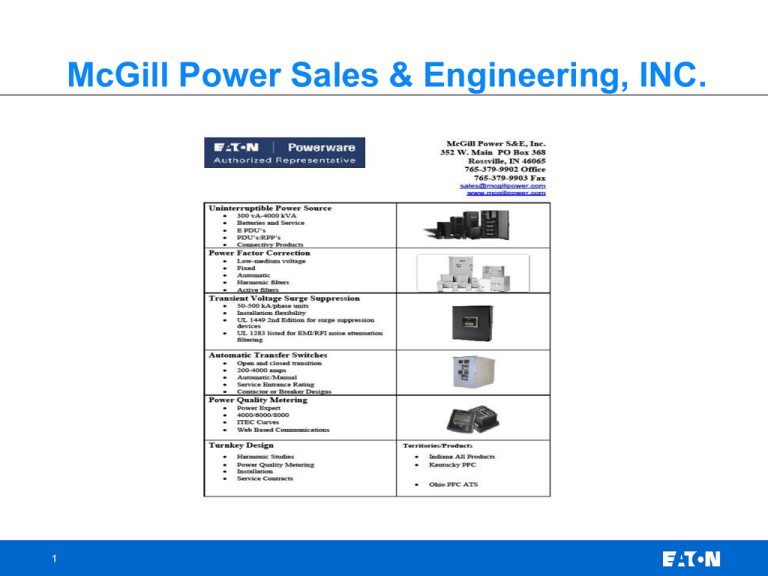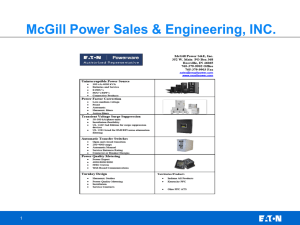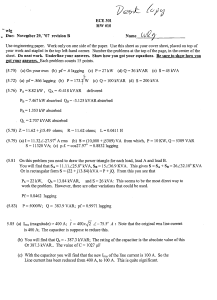
McGill Power Sales & Engineering, INC.
1
Power Factor Correction
Terry McGill
President
McGill Power Sales & Engineering Inc.
© 2007 Eaton Corporation. All rights reserved.
Agenda
• What is power factor?
• What are the costs of low power factor?
• What are the solutions to low power factor?
• Power factor correction selection considerations
• Design considerations and pitfalls
3
Power factor definition
• Power factor is the
ratio between the
“real” power and the
“apparent” power of an
electrical system
kVA
kVAr
kW
• “Real” power = working power = kW
• “Apparent” power = Volts x Amps = kVA
• “Reactive” power = magnetizing power = kVAR
4
Is the Glass Half Empty or Half Full?
Foam/Fizz
Capacity (KVAR)
Liquid (KW)
Full
Capacity
(KVA)
5
Utility must generate, transmit, and
distribute active AND reactive power
6
If reactive power could come from
another source – utility can reduce
7
Demonstration
Power Factor Demonstration Unit
© 2007 Eaton Corporation. All rights reserved.
Why Consider PFC?
PF correction provides many benefits:
• Primary Benefit:
• Reduced electric utility bill if there is a penalty
(a typical payback period is less than two years)
• Other Benefits:
• Increased system capacity
• Improved voltage regulation
• Reduced losses in transformers and cables
• May reduce harmonics on the power system (with
harmonic filters)
9
Where has all the money gone?
Energy
(kWh)
Demand
(kW)
PF Charges
+
10
Taxes
Typical Uncorrected Power Factor
Industry
Percent Uncorrected PF
Brewery
76-80
Cement
80-85
Chemical
65-75
Coal Mine
65-80
Clothing
35-60
Electroplating
65-70
Foundry
75-80
Forge
70-80
Hospital
75-80
Machine manufacturing
60-65
Metal working
65-70
Office building
80-90
Oil-field pumping
40-60
Paint manufacturing
55-65
Plastic
75-80
Stamping
60-70
Steelworks
65-80
11Textile
65-75
Low PF typically results from
unloaded or lightly loaded motors
Unloaded motor – PF = .20
Loaded motor – “rated PF” = .85
Typical Sources of Low Power Factor
• Reactive power is required by many loads to
provide magnetizing current for:
• Motors
• Power transformers
• Welding machines
• Electric arc furnaces
• Inductors
• Lighting ballasts
12
Cost to end user or consumerUtility fees and surcharges
• There is no free lunch!!
• Many utilities pass on
the extra costs they
incur through
penalties, surcharges
or other methods
• Methods of recovering
these costs vary with
each utility and can be
confusing to customers
13
Where do PF charges appear on a bill?
• Explicit
• Power Factor Penalty
• Power Factor Adjustment
• Power Factor Multiplier
• Reactive Demand Charge
• Calculated Demand
• Billed Demand
14
Where do PF charges appear on a bill?
• Shift to Temp 624 Model
15
Escalation in Electrical Energy Cost
• Electrical Energy cost
has increased nearly
50% over the last 10
years.
• Currently the PF
adjustment is being
increased.
6.5
Price/KWH (cents)
• The rate of increase
has accelerated in the
past few years.
Industrial Electrical Energy Cost by Year
6
5.5
5
4.5
4
1997 1998 1999 2000 2001 2002 2003 2004 2005 2006
Year
Source Energy Information Administration
16
Cost savings due to increased
capacity
• Correcting poor power
factor can significantly
reduce the load on
transformers and
conductors and allow
for facility expansion
• Transformers are rated
by kVA and must be
sized accordingly
17
Example – increase capacity with
new transformer
• Existing transformer is
500kVA
• Plant needs to add new
production line of 75kW
18
kVA = 500
kW = 400
kVAr =300
• Existing plant has a
power factor of 0.80 or
80% PF
Example – increase capacity with
new transformer
• Cost to increase capacity to accommodate new
production
• New transformer
• next standard size 750kVA
• Long lead-time
• Plant shut down to add new transformer – days?
• Labor and materials to install new transformer
• Upsize conductors for 750kVA transformer
• Disposal of old transformer
19
Example – increase capacity by
adding PFCC
20
Power Factor Correction
kVA = 412
kW =400
kVAr = 100
Power Factor Correction
and addition of 75kW
kVA = 485
kW =475
kVAr = 100
• Correct power factor
from 80% PF to 97% PF
by adding 200kVAR
power factor correction
capacitor
• Keep existing 500kVA
• Add 75kW of new load
• Existing 500kVA
transformer actually runs
cooler than before!!!!
Example – increase capacity by
adding PFCC
• Cost to increase capacity to accommodate new
production
• New power factor correction capacitor
• Minimal interruption to energize and start up new
capacitor system
21
How to correct poor power factor
© 2007 Eaton Corporation. All rights reserved.
Capacitor Selection
Capacitor selection issues (besides size)
• Utility penalties
• Installed cost, payback of equipment, and NPV
• Load variability
• Voltage regulation
• Load requirements (Speed of changing PF)
• Harmonic resonance
23
Effect of Location
R1
Resistive
Load
R2
Motor
Load
Place here for line loss
reduction and voltage
improvement
Place here for utility PF penalty
Place here for utility PF penalty
(utility owned transformer)
or
Place here to reduce losses in
transformer or free capacity
24
LV Fixed Capacitor Banks
• Designed for industrial and
commercial power systems
• Lowest installed cost
• var Range: 1 kvar to 400 kvar
• 208 Volts through 600 Volts AC
• Must be harmonic free
environment
25
LV Switched (Automatic) PFC Capacitors Banks
• Automatically sense changes in load
• Automatic Controller
• Steps of 50 kvar standard
Smaller wall mounted units are
available, and can be a real cost savings!
26
LV Harmonic Filtering Equipment
• Provides similar PF
correction (as caps)
• Avoid harmonic
capacitor interaction
problems
• “Filter” harmonics
to reduce voltage
and current
distortion
27
MV Capacitors
• Pole Mounted
• These banks have exposed live parts and
are typically supported on a wood power
pole.
• Rack Mounted
• These banks have exposed live parts and
are supported on a steel structure. These
banks are usually located in fenced-in
substations.
• Metal Enclosed or Pad Mounted
• These banks are typically enclosed in a
steel enclosure and are usually located
within a fenced-in substation or
switchgear room.
28
Cost of Power Factor Correction
TABLE 4
INSTALLED COST COMPARISON
OF POWER FACTOR CORRECTION EQUIPMENT
29
TYPE OF CORRECTION
INSTALLED COST,
$/KVAR
Fixed (LV – motor applied)
$15
Fixed (LV)
$25
Fixed (MV)
$30
Switched (LV)
$50
Switched (MV)
$50
Static Switched (LV)
$75
Switched Harmonic Filter (LV)
$75
Switched Harmonic Filter (MV)
$60
Active Harmonic Filter (LV)
$150
Additional Application
considerations
• Switching transients
• Potential resonance
30
Capacitor switching transients
• Capacitor energization (common event)
• Voltage difference between system and capacitor
• Capacitor voltage cannot change instantaneously
• System voltage pulled nearly to initial capacitor
voltage
• Inrush current as capacitor charges
• Voltage overshoots and oscillation occurs
31
Harmonics
Definition
• Steady state components of voltage and current at
higher frequencies than 60 Hz (or fundamental
frequency)
Causes
• ‘Nonlinear’ loads, normally electronic loads
• In industrial facility, predominately motor drives (AC
or DC), also large UPSs, computer loads, rectifiers
• These electronic loads draw non-sinusoidal current
• All load current (particularly transformers and motors)
has some amount of harmonic content
32
Expected Harmonics
Source
Typical Harmonics*
6 Pulse Drive/Rectifier
5, 7, 11, 13, 17, 19…
12 Pulse Drive /Rectifier
18 Pulse Drive
Switch-Mode Power Supply
Fluorescent Lights
Arcing Devices
Transformer Energization
11, 13, 23, 25…
17, 19, 35, 37…
3, 5, 7, 9, 11, 13…
3, 5, 7, 9, 11, 13…
2, 3, 4, 5, 7...
2, 3, 4
* Generally, magnitude decreases as harmonic order increases
H = NP+/-1
i.e. 6 Pulse Drive - 5, 7, 11, 13, 17, 19,…
33
Harmonic Resonance
If a capacitor exists on
the power system
AND
Harmonic producing
loads are in use
You MUST check for
harmonic resonance.
The “Self Correcting” Problem
•Blown Fuses
•Failed Capacitor
34
(Series and Parallel)
Harmonic Resonance - Solutions
1. Change the method of kvar compensation (harmonic
filter, active filter, etc.)
2. Change the size of the capacitor bank to overcompensate or under-compensate for the required kvar
and live with the ramifications (i.e. overvoltage or PF
penalty).
Natural System frequency of oscillation typically at 5th to 13th harmonic
35
When is resonance a concern ?
Several factors must converge simultaneously for
resonance to be a potential problem
1) P.F. correction kVAr >25% of xfmr kVA
2) Nonlinear load > 25% of xfmr kVA
3) Larger, fixed capacitance
Often, resonance effects exist to some degree, but is not
severe enough to cause problems
36
When is resonance not a concern ?
Resonance not generally a concern when:
• Total kVAR <15% system kVA
• Total nonlinear load <25% of system kVA
• Adding capacitors to individual motors
37
How to know for sure?
Resonance will happen when:
Ht = (Sqrt ((xfmer kva / z)/kvar))
Ht = (Sqrt((1000/.058)/300)
Ht = (Sqrt(17,241/300))
Ht = (Sqrt (57.47))
Ht = 7.58
•
Record harmonic data.
•
Determine resonance points.
•
Compare to required kVAr.
38
Questions
?
39
Power Quality Experience Center and Lab
• Overview of Lab and Capabilities
• Purpose
• To demonstrate and Test PQ
Problems and Solutions
• Power Quality solutions, especially
harmonic solutions, are difficult to
understand
• Demystify solutions – mis-information and confusion regarding PQ and
energy savings
• Equipment (Harmonic Related)
•
• 18 Pulse Drives
• Passive (Fixed) Filters
• HMT’s
• Passive (Switched) Filters
• Active Filters
• Active Rectifier (UPS)
• Broadband Filters
• Reactors
Link:http://www.eaton.com/EatonCom/Markets/Electrical/ServicesSupport/Experi
ence/index.htm – Simply search on Google for Eaton Experience Center
40
Thank You.
41




